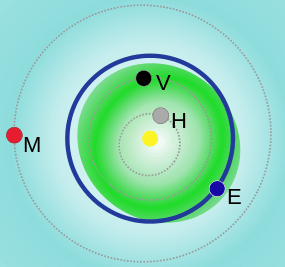2000 SG344
|
The dim streak in this negative image is 2000 SG344 moving against the background field of stars on Sept. 29, 2000. | |
| Discovery[1] | |
|---|---|
| Discovered by | D. J. Tholen, and R. J. Whiteley |
| Discovery site | Mauna Kea Observatory - UH88 |
| Discovery date | 2000-09-29 |
| Designations | |
Aten  | |
| Orbital characteristics[2] | |
| Epoch 13 January 2016 (JD 2457400.5) | |
| Uncertainty parameter 2 | |
| Observation arc | 507 days (1.39 yr) |
| Aphelion | 1.04290676 AU (156.016631 Gm) |
| Perihelion | 0.9121378 AU (136.45387 Gm) |
| 0.97752227 AU (146.235250 Gm) | |
| Eccentricity | 0.0668880 |
| 0.97 yr (353.0 d) | |
| 203.927253° | |
| 1.0197978°/day | |
| Inclination | 0.1114092° |
| 192.052019° | |
| 275.163016° | |
| Earth MOID | 0.000907713 AU (135,791.9 km) |
| Jupiter MOID | 3.96971 AU (593.860 Gm) |
| Physical characteristics | |
| Dimensions | 37 meters (121 ft)[3] |
| Mass | 7.1×107 kg[3] |
| 24.7[2] | |
|
| |
2000 SG344 (also written 2000 SG344) is a small Aten asteroid discovered in 2000. It is estimated to have a diameter of 37 meters (twice that of the Chelyabinsk meteor) and a mass of 7.1×107 kg (71,000 tonnes).[3]
Because of its very Earth-like orbit and because it would have been near the Earth in 1971 (coinciding with the Apollo program), there was speculation that 2000 SG344 might not be an asteroid but a man-made object such as an S-IVB booster stage from a Saturn V rocket[4][5] (cf. J002E3, the S-IVB booster of Apollo 12 which was mistaken for an asteroid.)
Possible impacts with Earth
Until December 2004, it was considered to have the highest (though still very low) likelihood of any near-Earth object to impact Earth in the next 100 years. It is ranked a zero on the Torino scale of impact risk because of its small size (the scale is 0–10) and is listed on Sentry Risk Table.[3][6] It was briefly surpassed in December 2004 by 99942 Apophis (which at the time was known only by its provisional designation 2004 MN4). The smaller asteroids 2006 JY26 and 2010 RF12 have a greater chance of impacting Earth.
Based on 31 observations of 2000 SG344 made from May 1999 to October 2000, there is about a 1 in 417 chance that it will collide with Earth between 2069 and 2113. Assuming the object is a rocky asteroid, the impact energy released would be an estimated 1.1 megatons of TNT,[3] which would create an impact crater approximately 100 feet (30 m) wide assuming it does not explode in the atmosphere.
Planned NASA mission
NASA is considering it as a possible target for a manned mission (Exploration Mission 2) using the Orion spacecraft, prior to a projected 2030 push to Mars.[7][8] 2000 SG344 will be observable in April 2028 at an apparent magnitude of 19.[9]
References
- ↑ "IAU Circular: MPEC 2000-U19". 2000-10-24. Retrieved 18 May 2008.
- 1 2 "JPL Small-Body Database Browser on 2000 SG344". NASA. Retrieved 18 May 2008.
- 1 2 3 4 5 "2000 SG344 Earth Impact Risk Summary". 2002-05-15. Archived from the original on 24 October 2004. Retrieved 2004-11-12.
- ↑ "Much Ado about 2000 SG344". NASA. 2000-11-07. Retrieved 19 May 2008.
- ↑ Chodas, P. W.; Chesley, S. R. (November 2001). "2000 SG344: The Story of a Potential Earth Impactor". Bulletin of the American Astronomical Society. 33: 1196. Retrieved 19 May 2008.
- ↑ "NASA Near Earth Object Program: Current Impact Risks". Archived from the original on 2013-05-29. Retrieved 2004-11-12.
- ↑ Sample, Ian (2008-05-07). "Closer encounter: Nasa plans landing on 40m-wide asteroid travelling at 28,000mph". The Guardian. Archived from the original on 9 May 2008. Retrieved 9 May 2008.
- ↑ Into the Beyond: A Crewed Mission to an Near-Earth Object - text slides
- ↑ "Near-Earth Object Human Space Flight Accessible Targets Study (NHATS)". NASA/JPL Near-Earth Object Program Office. Retrieved 2012-06-08.
Further reading
- "IAU Circular: MPEC 2000-U19". 2000-10-24. Retrieved 18 May 2008.
- "IAU Circular: MPEC 2000-U24". 2000-10-25. Retrieved 9 May 2008.
- "IAU Circular: MPEC 2000-V26". 2000-11-08. Retrieved 9 May 2008.
External links
- 2000 SG344 at the JPL Small-Body Database

- NASA NEO Study home page
